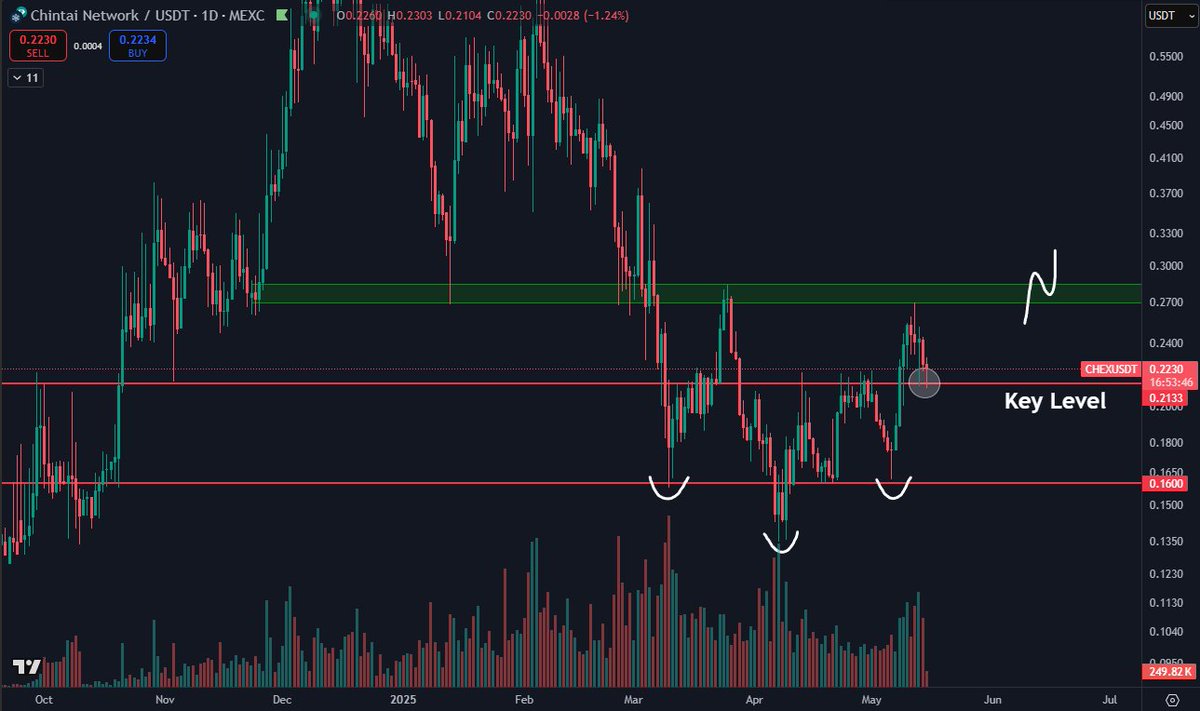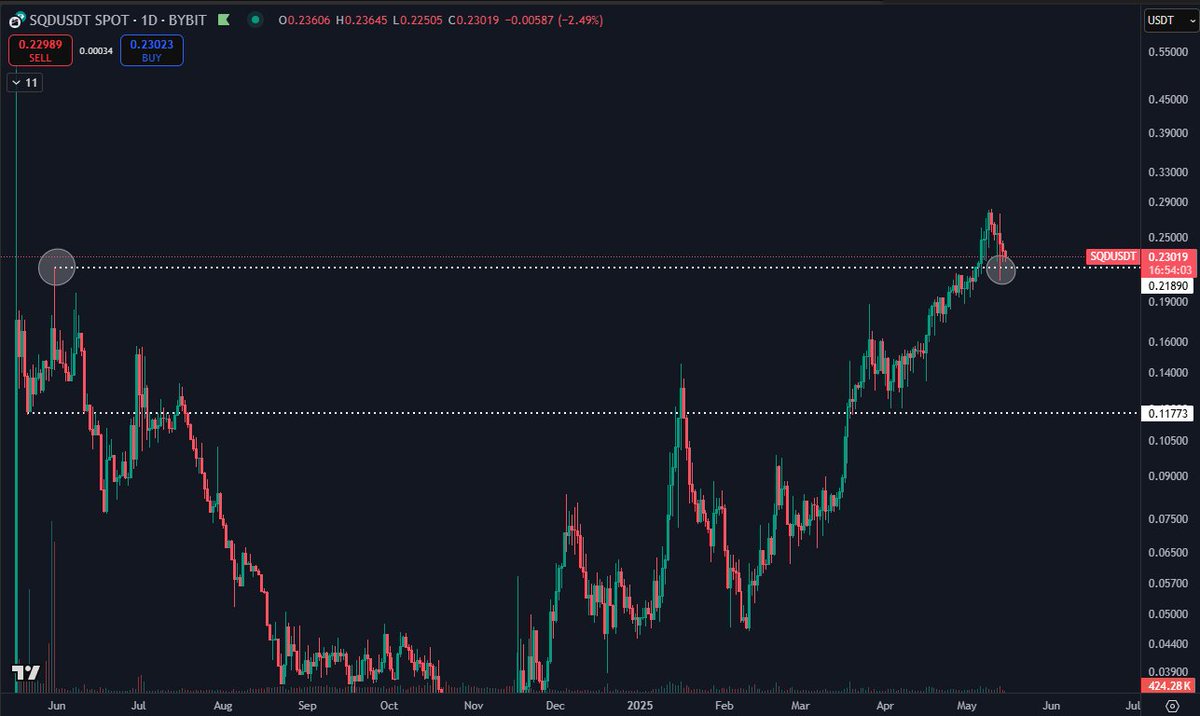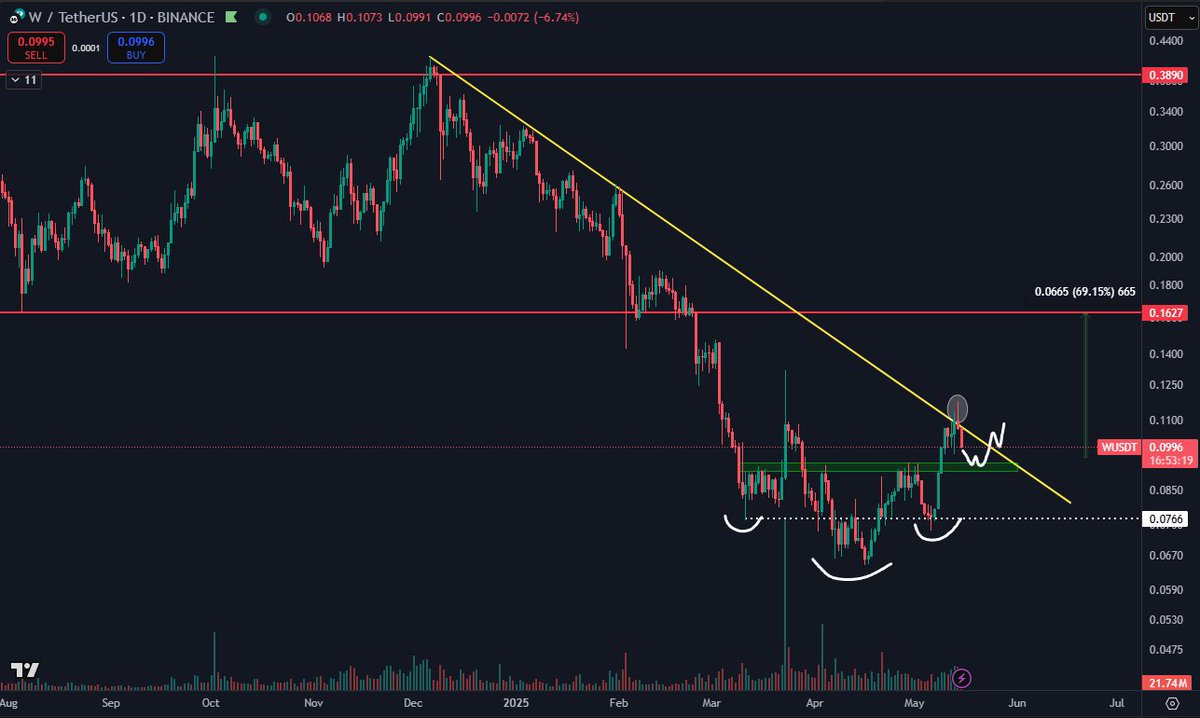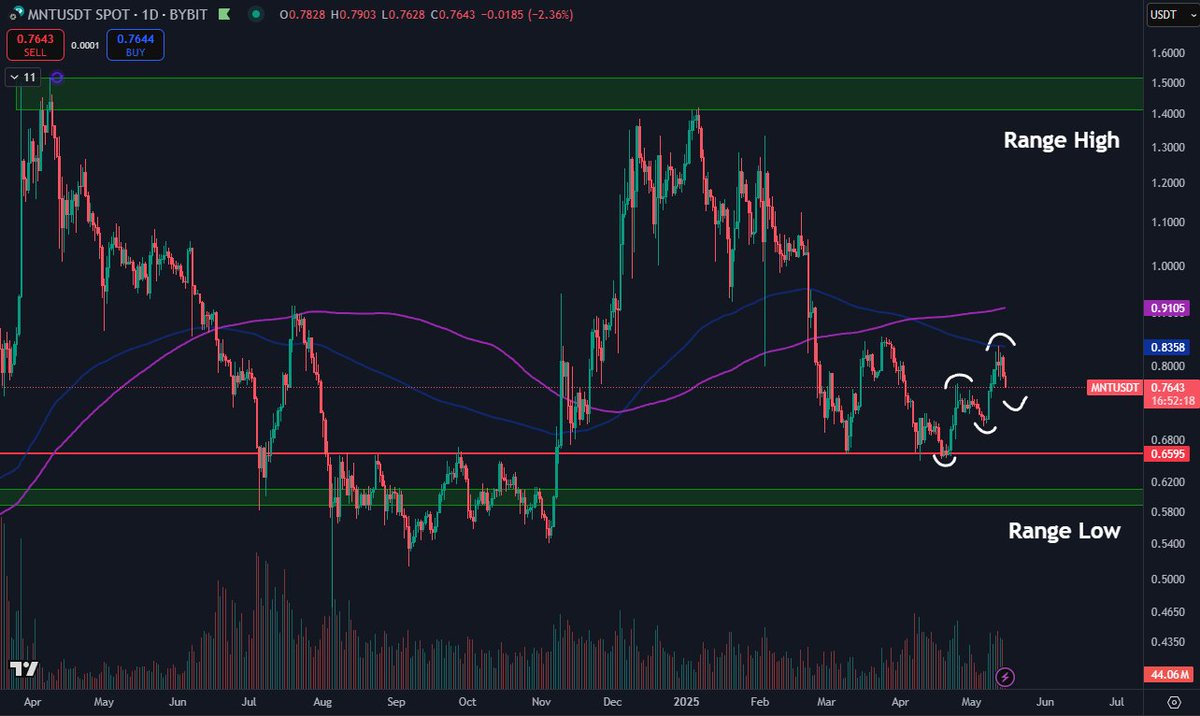
W
Cours du Wormhole
$0,10312
-$0,00395
(-3,69 %)
Évolution du cours sur les dernières 24 heures

Que ressentez-vous pour W aujourd’hui ?
Donnez votre avis en ajoutant un pouce vers le haut si vous pensez que le cours Ethereum et la valeur Ethereum sont en hausse, ou un pouce en bas si vous estimez que le prix Ethereum et le ETH / USD vont baisser. Suivez l’évolution Ethereum en temps réel et consultez le Ethereum cours dollar et le Ethereum cours euro pour anticiper les tendances du marché.
Votez pour voir les résultats
Avis de non-responsabilité
Le contenu social sur cette page (« Contenu »), y compris mais sans s’y limiter les tweets et les statistiques fournis par LunarCrush, est issu de tiers et fourni « tel quel » à des fins d’information uniquement. OKX ne garantit ni la qualité ni l’exactitude du Contenu, et le Contenu ne représente pas les opinions d’OKX. Il n’est pas destiné à dispenser (i) des conseils ou recommandations en matière d’investissement ; il ne doit pas (ii) non plus être considéré comme une invitation à acheter, à vendre ni à détenir des actifs numériques, ni (iii) comme des conseils financiers, comptables, juridiques ou fiscaux. Les actifs numériques (dont les stablecoins et les NFT) présentent un niveau de risque élevé, et leur valeur peut varier considérablement. Les cours et les performances des actifs numériques ne sont pas garantis et peuvent changer sans préavis.</br></br>OKX ne fournit aucune recommandation en matière d’investissement ou d’actif. Évaluez attentivement votre situation financière pour déterminer si vous êtes en mesure de détenir ou de trader des actifs numériques. Demandez conseil auprès de votre expert juridique, fiscal ou en investissement pour toute question portant sur votre situation personnelle. Pour plus de détails, consultez nos <a href="/help/terms-of-service">Conditions d’utilisation</a> et notre <a href="/help/risk-compliance-disclosure">Avertissement sur les risques</a>. En utilisant le site Web tiers (« SWT »), vous acceptez que toute utilisation du SWT soit soumise et régie par les conditions du SWT. Sauf mention écrite expresse, OKX et ses sociétés affiliées (« OKX ») ne sont en aucun cas associées au propriétaire ou à l’exploitant du SWT. Vous acceptez qu’OKX ne soit responsable d’aucune perte, d’aucun dommage et d’aucune autre conséquence découlant de votre utilisation du SWT. Sachez que l’utilisation d’un SWT peut déboucher sur la perte ou la baisse de vos actifs. Le produit peut être indisponible dans certaines juridictions.
Infos sur le marché du Wormhole
Cap. boursière
La cap. boursière est calculée en multipliant l’offre en circulation d’un jeton par son dernier cours.
Cap. boursière = offre en circulation × dernier cours
Cap. boursière = offre en circulation × dernier cours
Approvisionnement en circulation
La quantité totale d’un jeton qui est accessible au public sur le marché.
Classement de cap. boursière
La position d’un jeton dans le classement par cap. boursière.
Sommet historique
Cours le plus élevé atteint par un jeton au cours de son historique de trading.
Minimum historique
Cours le plus bas atteint par un jeton au cours de son historique de trading.
Cap. boursière
$471,46M
Approvisionnement en circulation
4 581 271 240 W
45,81 % de
10 000 000 000 W
Classement de cap. boursière
--
Audits

Dernier audit : 9 mars 2023
Pic sur 24 h
$0,10848
Creux sur 24 h
$0,096140
Sommet historique
$1,8200
-94,34 % (-$1,7169)
Dernière mise à jour : 3 avr. 2024
Minimum historique
$0,064700
+59,38 % (+$0,038420)
Dernière mise à jour : 17 avr. 2025
Flux de Wormhole
Le contenu suivant provient de .

Wormhole
Sommet des développeurs de trous de ver à @SolanaConf
📅 Mardi 20 mai | 10 h 45 à 15 h 15
Rejoignez @0xKATYA, @PauChan23, @evgenidefi, @nsuri_ et des invités spéciaux pour une journée exclusive de démonstrations de produits, d’ateliers techniques, d’AMA et plus encore.
Réservez votre place ⏬
Afficher l’original
5,91 k
31

Everstake
🚨 Le programme de récompenses de jalonnement de @wormhole est toujours en ligne - avec au moins 50 millions de $W de récompenses disponibles. Pour rester éligible, assurez-vous de participer à la gouvernance avec votre participation.
Rappel : @solana stakers doivent migrer vers le système de gouvernance mis à jour.
Vous pouvez voter vous-même ou déléguer votre vote à une personne de confiance. Regardez la vidéo pour savoir comment déléguer à Everstake ! 👇
Afficher l’original11,53 k
9

Daan Crypto Trades
Le marché se refroidit après quelques semaines.
C’est là que le vrai test commence, car de nombreux mouvements ont été alimentés par des short squeezes. Nous allons maintenant voir où intervient la demande au comptant.
Certaines pièces avec la zone de support HTF que je regarde.
$CHEX $SQD $W $MNT
Afficher l’original



17,63 k
114

Everstake a reposté

Wormhole
🚨 Mise à jour du programme de récompenses de jalonnement Wormhole
Les participants qui misent sur Solana doivent migrer vers le contrat Solana mis à niveau via le tableau de bord W pour rester éligibles aux distributions de récompenses.
Miser, migrer, déléguer, participer :
Afficher l’original
24,5 k
325
Calculateur W


Performance du cours de Wormhole en USD
Le cours de Wormhole est actuellement de $0,10312. Au cours des dernières 24 heures, la valeur Wormhole a a diminué de -3,69 %. Il a actuellement une offre en circulation de 4 581 271 240 W et une offre maximale de 10 000 000 000 W, ce qui lui donne une capitalisation boursière totalement diluée de $471,46M. Actuellement, le jeton Wormhole occupe la 0 position du classement par capitalisation boursière. Le cours Wormhole/USD est mis à jour en temps réel.
Aujourd'hui
-$0,00395
-3,69 %
7 jours
+$0,015180
+17,26 %
30 jours
+$0,033030
+47,12 %
3 mois
-$0,08078
-43,93 %
Conversions de Wormhole populaires
Dernière mise à jour : 16/05/2025 01:39
| 1 W en USD | 0,10291 $ |
| 1 W en EUR | 0,091899 € |
| 1 W en PHP | 5,7496 ₱ |
| 1 W en IDR | 1 705,78 Rp |
| 1 W en GBP | 0,077491 £ |
| 1 W en CAD | 0,14407 $ |
| 1 W en AED | 0,37768 AED |
| 1 W en VND | 2 670,91 ₫ |
À propos du Wormhole (W)
La notation fournie correspond à une notation agrégée qui est collectée par OKX à partir des sources fournies. Elle n’est indiquée qu’à titre indicatif. OKX ne garantit ni la qualité ni l’exactitude des notations. Elle n’est pas destinée à dispenser (i) des conseils ou recommandations en matière d’investissement ; elle ne doit pas (ii) non plus être considérée comme une invitation à acheter, à vendre ni à détenir des actifs numériques, ni (iii) comme des conseils financiers, comptables, juridiques ou fiscaux. Les actifs numériques (dont les stablecoins et les NFT) présentent un niveau de risque élevé ; leur valeur peut varier considérablement, voire devenir nulle. Les prix et les performances des actifs numériques ne sont pas garantis et peuvent changer sans préavis. Vos actifs numériques ne sont pas couverts par une assurance contre les pertes potentielles. Les rendements historiques ne constituent pas un indicateur des rendements futurs. OKX ne garantit aucun rendement, ni le remboursement du capital et des intérêts. Évaluez attentivement votre situation financière pour déterminer si vous êtes en mesure de détenir des actifs numériques ou de réaliser des activités de trading. Demandez conseil auprès de votre expert juridique/fiscal/en investissement pour toute question portant sur votre propre situation.
Afficher plus
- Site web officiel
- Livre blanc
- Github
- Explorateur de blocs
À propos des sites Web tiers
À propos des sites Web tiers
En utilisant le site web tiers (« SWT »), vous acceptez que toute utilisation du SWT soit sujette aux conditions du SWT et gouvernée par celles-ci. Sauf mention écrite expresse, OKX et ses affiliés (« OKX ») ne sont en aucun cas associés au propriétaire ni à l’opérateur du SWT. Vous acceptez le fait qu’OKX ne soit pas responsable des pertes, dommages ni de toutes autres conséquences découlant de votre utilisation du SWT. Veuillez noter que l’utilisation d’un SWT peut entraîner une perte ou une diminution de vos actifs.
FAQ Wormhole
Combien vaut 1 Wormhole aujourd’hui ?
Actuellement, 1 Wormhole vaut $0,10312. Vous recherchez des informations sur les mouvements de prix du token Wormhole ? Vous êtes au bon endroit ! Découvrez les graphiques les plus récents sur le token Wormhole et tradez de manière responsable avec OKX.
Qu'est-ce que la cryptomonnaie ?
Les cryptomonnaies, telles que les Wormhole, sont des actifs numériques fonctionnant sur un registre public appelé blockchain. En savoir plus sur les jetons proposés sur OKX et leurs différents attributs, notamment le cours en direct et les graphiques en temps réel.
Quand la cryptomonnaie a-t-elle été inventée ?
En raison de la crise financière de 2008, l’intérêt porté à la finance décentralisée a explosé. Le Bitcoin offrait une solution novatrice en tant qu’actif numérique sécurisé sur un réseau décentralisé. De nombreux jetons tels que les Wormhole ont également été créés depuis lors.
Le cours du Wormhole va-t-il augmenter aujourd'hui ?
Consultez notre Page de prédiction des cours de Wormhole pour prévoir les cours à venir et déterminer vos objectifs de cours.
Déclaration ESG
Les réglementations ESG (approche environnementale, sociale et de gouvernance) relatives aux actifs crypto visent à réduire leur impact environnemental (par exemple : l'extraction minière à forte intensité énergétique), à promouvoir la transparence et à garantir des pratiques de gouvernance éthiques afin d'aligner le secteur des cryptos sur des objectifs plus larges en matière de durabilité et de société. Ces réglementations encouragent le respect de normes qui atténuent les risques et favorisent la confiance dans les actifs numériques.
Détails de l’actif
Nom
OKcoin Europe LTD
Identifiant de l’entité juridique concernée
54930069NLWEIGLHXU42
Nom de l’actif crypto
Wormhole Token
Mécanisme de consensus
Wormhole Token is present on the following networks: arbitrum, ethereum, optimism, solana.
Arbitrum is a Layer 2 solution on top of Ethereum that uses Optimistic Rollups to enhance scalability and reduce transaction costs. It assumes that transactions are valid by default and only verifies them if there's a challenge (optimistic): Core Components: • Sequencer: Orders transactions and creates batches for processing. • Bridge: Facilitates asset transfers between Arbitrum and Ethereum. • Fraud Proofs: Protect against invalid transactions through an interactive verification process. Verification Process: 1. Transaction Submission: Users submit transactions to the Arbitrum Sequencer, which orders and batches them. 2. State Commitment: These batches are submitted to Ethereum with a state commitment. 3. Challenge Period: Validators have a specific period to challenge the state if they suspect fraud. 4. Dispute Resolution: If a challenge occurs, the dispute is resolved through an iterative process to identify the fraudulent transaction. The final operation is executed on Ethereum to determine the correct state. 5. Rollback and Penalties: If fraud is proven, the state is rolled back, and the dishonest party is penalized. Security and Efficiency: The combination of the Sequencer, bridge, and interactive fraud proofs ensures that the system remains secure and efficient. By minimizing on-chain data and leveraging off-chain computations, Arbitrum can provide high throughput and low fees.
The Ethereum network uses a Proof-of-Stake Consensus Mechanism to validate new transactions on the blockchain. Core Components 1. Validators: Validators are responsible for proposing and validating new blocks. To become a validator, a user must deposit (stake) 32 ETH into a smart contract. This stake acts as collateral and can be slashed if the validator behaves dishonestly. 2. Beacon Chain: The Beacon Chain is the backbone of Ethereum 2.0. It coordinates the network of validators and manages the consensus protocol. It is responsible for creating new blocks, organizing validators into committees, and implementing the finality of blocks. Consensus Process 1. Block Proposal: Validators are chosen randomly to propose new blocks. This selection is based on a weighted random function (WRF), where the weight is determined by the amount of ETH staked. 2. Attestation: Validators not proposing a block participate in attestation. They attest to the validity of the proposed block by voting for it. Attestations are then aggregated to form a single proof of the block’s validity. 3. Committees: Validators are organized into committees to streamline the validation process. Each committee is responsible for validating blocks within a specific shard or the Beacon Chain itself. This ensures decentralization and security, as a smaller group of validators can quickly reach consensus. 4. Finality: Ethereum 2.0 uses a mechanism called Casper FFG (Friendly Finality Gadget) to achieve finality. Finality means that a block and its transactions are considered irreversible and confirmed. Validators vote on the finality of blocks, and once a supermajority is reached, the block is finalized. 5. Incentives and Penalties: Validators earn rewards for participating in the network, including proposing blocks and attesting to their validity. Conversely, validators can be penalized (slashed) for malicious behavior, such as double-signing or being offline for extended periods. This ensures honest participation and network security.
Optimism is a Layer 2 scaling solution for Ethereum that uses Optimistic Rollups to increase transaction throughput and reduce costs while inheriting the security of the Ethereum main chain. Core Components 1. Optimistic Rollups: Rollup Blocks: Transactions are batched into rollup blocks and processed off-chain. State Commitments: The state of these transactions is periodically committed to the Ethereum main chain. 2. Sequencers: Transaction Ordering: Sequencers are responsible for ordering transactions and creating batches. State Updates: Sequencers update the state of the rollup and submit these updates to the Ethereum main chain. Block Production: They construct and execute Layer 2 blocks, which are then posted to Ethereum. 3. Fraud Proofs: Assumption of Validity: Transactions are assumed to be valid by default. Challenge Period: A specific time window during which anyone can challenge a transaction by submitting a fraud proof. Dispute Resolution: If a transaction is challenged, an interactive verification game is played to determine its validity. If fraud is detected, the invalid state is rolled back, and the dishonest participant is penalized. Consensus Process 1. Transaction Submission: Users submit transactions to the sequencer, which orders them into batches. 2. Batch Processing: The sequencer processes these transactions off-chain, updating the Layer 2 state. 3. State Commitment: The updated state and the batch of transactions are periodically committed to the Ethereum main chain. This is done by posting the state root (a cryptographic hash representing the state) and transaction data as calldata on Ethereum. 4. Fraud Proofs and Challenges: Once a batch is posted, there is a challenge period during which anyone can submit a fraud proof if they believe a transaction is invalid. Interactive Verification: The dispute is resolved through an interactive verification game, which involves breaking down the transaction into smaller steps to identify the exact point of fraud. Rollbacks and Penalties: If fraud is proven, the batch is rolled back, and the dishonest actor loses their staked collateral as a penalty. 5. Finality: After the challenge period, if no fraud proof is submitted, the batch is considered final. This means the transactions are accepted as valid, and the state updates are permanent.
Solana uses a unique combination of Proof of History (PoH) and Proof of Stake (PoS) to achieve high throughput, low latency, and robust security. Here’s a detailed explanation of how these mechanisms work: Core Concepts 1. Proof of History (PoH): Time-Stamped Transactions: PoH is a cryptographic technique that timestamps transactions, creating a historical record that proves that an event has occurred at a specific moment in time. Verifiable Delay Function: PoH uses a Verifiable Delay Function (VDF) to generate a unique hash that includes the transaction and the time it was processed. This sequence of hashes provides a verifiable order of events, enabling the network to efficiently agree on the sequence of transactions. 2. Proof of Stake (PoS): Validator Selection: Validators are chosen to produce new blocks based on the number of SOL tokens they have staked. The more tokens staked, the higher the chance of being selected to validate transactions and produce new blocks. Delegation: Token holders can delegate their SOL tokens to validators, earning rewards proportional to their stake while enhancing the network's security. Consensus Process 1. Transaction Validation: Transactions are broadcast to the network and collected by validators. Each transaction is validated to ensure it meets the network’s criteria, such as having correct signatures and sufficient funds. 2. PoH Sequence Generation: A validator generates a sequence of hashes using PoH, each containing a timestamp and the previous hash. This process creates a historical record of transactions, establishing a cryptographic clock for the network. 3. Block Production: The network uses PoS to select a leader validator based on their stake. The leader is responsible for bundling the validated transactions into a block. The leader validator uses the PoH sequence to order transactions within the block, ensuring that all transactions are processed in the correct order. 4. Consensus and Finalization: Other validators verify the block produced by the leader validator. They check the correctness of the PoH sequence and validate the transactions within the block. Once the block is verified, it is added to the blockchain. Validators sign off on the block, and it is considered finalized. Security and Economic Incentives 1. Incentives for Validators: Block Rewards: Validators earn rewards for producing and validating blocks. These rewards are distributed in SOL tokens and are proportional to the validator’s stake and performance. Transaction Fees: Validators also earn transaction fees from the transactions included in the blocks they produce. These fees provide an additional incentive for validators to process transactions efficiently. 2. Security: Staking: Validators must stake SOL tokens to participate in the consensus process. This staking acts as collateral, incentivizing validators to act honestly. If a validator behaves maliciously or fails to perform, they risk losing their staked tokens. Delegated Staking: Token holders can delegate their SOL tokens to validators, enhancing network security and decentralization. Delegators share in the rewards and are incentivized to choose reliable validators. 3. Economic Penalties: Slashing: Validators can be penalized for malicious behavior, such as double-signing or producing invalid blocks. This penalty, known as slashing, results in the loss of a portion of the staked tokens, discouraging dishonest actions.
Mécanismes d’incitation et frais applicables
Wormhole Token is present on the following networks: arbitrum, ethereum, optimism, solana.
Arbitrum One, a Layer 2 scaling solution for Ethereum, employs several incentive mechanisms to ensure the security and integrity of transactions on its network. The key mechanisms include: 1. Validators and Sequencers: o Sequencers are responsible for ordering transactions and creating batches that are processed off-chain. They play a critical role in maintaining the efficiency and throughput of the network. o Validators monitor the sequencers' actions and ensure that transactions are processed correctly. Validators verify the state transitions and ensure that no invalid transactions are included in the batches. 2. Fraud Proofs: o Assumption of Validity: Transactions processed off-chain are assumed to be valid. This allows for quick transaction finality and high throughput. o Challenge Period: There is a predefined period during which anyone can challenge the validity of a transaction by submitting a fraud proof. This mechanism acts as a deterrent against malicious behavior. o Dispute Resolution: If a challenge is raised, an interactive verification process is initiated to pinpoint the exact step where fraud occurred. If the challenge is valid, the fraudulent transaction is reverted, and the dishonest actor is penalized. 3. Economic Incentives: o Rewards for Honest Behavior: Participants in the network, such as validators and sequencers, are incentivized through rewards for performing their duties honestly and efficiently. These rewards come from transaction fees and potentially other protocol incentives. o Penalties for Malicious Behavior: Participants who engage in dishonest behavior or submit invalid transactions are penalized. This can include slashing of staked tokens or other forms of economic penalties, which serve to discourage malicious actions. Fees on the Arbitrum One Blockchain 1. Transaction Fees: o Layer 2 Fees: Users pay fees for transactions processed on the Layer 2 network. These fees are typically lower than Ethereum mainnet fees due to the reduced computational load on the main chain. o Arbitrum Transaction Fee: A fee is charged for each transaction processed by the sequencer. This fee covers the cost of processing the transaction and ensuring its inclusion in a batch. 2. L1 Data Fees: o Posting Batches to Ethereum: Periodically, the state updates from the Layer 2 transactions are posted to the Ethereum mainnet as calldata. This involves a fee, known as the L1 data fee, which accounts for the gas required to publish these state updates on Ethereum. o Cost Sharing: Because transactions are batched, the fixed costs of posting state updates to Ethereum are spread across multiple transactions, making it more cost-effective for users.
Ethereum, particularly after transitioning to Ethereum 2.0 (Eth2), employs a Proof-of-Stake (PoS) consensus mechanism to secure its network. The incentives for validators and the fee structures play crucial roles in maintaining the security and efficiency of the blockchain. Incentive Mechanisms 1. Staking Rewards: Validator Rewards: Validators are essential to the PoS mechanism. They are responsible for proposing and validating new blocks. To participate, they must stake a minimum of 32 ETH. In return, they earn rewards for their contributions, which are paid out in ETH. These rewards are a combination of newly minted ETH and transaction fees from the blocks they validate. Reward Rate: The reward rate for validators is dynamic and depends on the total amount of ETH staked in the network. The more ETH staked, the lower the individual reward rate, and vice versa. This is designed to balance the network's security and the incentive to participate. 2. Transaction Fees: Base Fee: After the implementation of Ethereum Improvement Proposal (EIP) 1559, the transaction fee model changed to include a base fee that is burned (i.e., removed from circulation). This base fee adjusts dynamically based on network demand, aiming to stabilize transaction fees and reduce volatility. Priority Fee (Tip): Users can also include a priority fee (tip) to incentivize validators to include their transactions more quickly. This fee goes directly to the validators, providing them with an additional incentive to process transactions efficiently. 3. Penalties for Malicious Behavior: Slashing: Validators face penalties (slashing) if they engage in malicious behavior, such as double-signing or validating incorrect information. Slashing results in the loss of a portion of their staked ETH, discouraging bad actors and ensuring that validators act in the network's best interest. Inactivity Penalties: Validators also face penalties for prolonged inactivity. This ensures that validators remain active and engaged in maintaining the network's security and operation. Fees Applicable on the Ethereum Blockchain 1. Gas Fees: Calculation: Gas fees are calculated based on the computational complexity of transactions and smart contract executions. Each operation on the Ethereum Virtual Machine (EVM) has an associated gas cost. Dynamic Adjustment: The base fee introduced by EIP-1559 dynamically adjusts according to network congestion. When demand for block space is high, the base fee increases, and when demand is low, it decreases. 2. Smart Contract Fees: Deployment and Interaction: Deploying a smart contract on Ethereum involves paying gas fees proportional to the contract's complexity and size. Interacting with deployed smart contracts (e.g., executing functions, transferring tokens) also incurs gas fees. Optimizations: Developers are incentivized to optimize their smart contracts to minimize gas usage, making transactions more cost-effective for users. 3. Asset Transfer Fees: Token Transfers: Transferring ERC-20 or other token standards involves gas fees. These fees vary based on the token's contract implementation and the current network demand.
Optimism, an Ethereum Layer 2 scaling solution, uses Optimistic Rollups to increase transaction throughput and reduce costs while maintaining security and decentralization. Here's an in-depth look at the incentive mechanisms and applicable fees within the Optimism protocol: Incentive Mechanisms 1. Sequencers: Transaction Ordering: Sequencers are responsible for ordering and batching transactions off-chain. They play a critical role in maintaining the efficiency and speed of the network. Economic Incentives: Sequencers earn transaction fees from users. These fees incentivize sequencers to process transactions quickly and accurately. 2. Validators and Fraud Proofs: Assumption of Validity: In Optimistic Rollups, transactions are assumed to be valid by default. This allows for quick transaction finality. Challenge Mechanism: Validators (or anyone) can challenge the validity of a transaction by submitting a fraud proof during a specified challenge period. This mechanism ensures that invalid transactions are detected and reverted. Challenge Rewards: Successful challengers are rewarded for identifying and proving fraudulent transactions. This incentivizes participants to actively monitor the network for invalid transactions, thereby enhancing security. 3. Economic Penalties: Fraud Proof Penalties: If a sequencer includes an invalid transaction and it is successfully challenged, they face economic penalties, such as losing a portion of their staked collateral. This discourages dishonest behavior. Inactivity and Misbehavior: Validators and sequencers are also incentivized to remain active and behave correctly, as inactivity or misbehavior can lead to penalties and loss of rewards. Fees Applicable on the Optimism Layer 2 Protocol 1. Transaction Fees: Layer 2 Transaction Fees: Users pay fees for transactions processed on the Layer 2 network. These fees are generally lower than Ethereum mainnet fees due to the reduced computational load on the main chain. Cost Efficiency: By batching multiple transactions into a single batch, Optimism reduces the overall cost per transaction, making it more economical for users. 2. L1 Data Fees: Posting Batches to Ethereum: Periodically, the state updates from Layer 2 transactions are posted to the Ethereum mainnet as calldata. This involves a fee known as the L1 data fee, which covers the gas cost of publishing these state updates on Ethereum. Cost Sharing: The fixed costs of posting state updates to Ethereum are spread across multiple transactions within a batch, reducing the cost burden on individual transactions. 3. Smart Contract Fees: Execution Costs: Fees for deploying and interacting with smart contracts on Optimism are based on the computational resources required. This ensures that users are charged proportionally for the resources they consume.
Solana uses a combination of Proof of History (PoH) and Proof of Stake (PoS) to secure its network and validate transactions. Here’s a detailed explanation of the incentive mechanisms and applicable fees: Incentive Mechanisms 4. Validators: Staking Rewards: Validators are chosen based on the number of SOL tokens they have staked. They earn rewards for producing and validating blocks, which are distributed in SOL. The more tokens staked, the higher the chances of being selected to validate transactions and produce new blocks. Transaction Fees: Validators earn a portion of the transaction fees paid by users for the transactions they include in the blocks. This provides an additional financial incentive for validators to process transactions efficiently and maintain the network's integrity. 5. Delegators: Delegated Staking: Token holders who do not wish to run a validator node can delegate their SOL tokens to a validator. In return, delegators share in the rewards earned by the validators. This encourages widespread participation in securing the network and ensures decentralization. 6. Economic Security: Slashing: Validators can be penalized for malicious behavior, such as producing invalid blocks or being frequently offline. This penalty, known as slashing, involves the loss of a portion of their staked tokens. Slashing deters dishonest actions and ensures that validators act in the best interest of the network. Opportunity Cost: By staking SOL tokens, validators and delegators lock up their tokens, which could otherwise be used or sold. This opportunity cost incentivizes participants to act honestly to earn rewards and avoid penalties. Fees Applicable on the Solana Blockchain 7. Transaction Fees: Low and Predictable Fees: Solana is designed to handle a high throughput of transactions, which helps keep fees low and predictable. The average transaction fee on Solana is significantly lower compared to other blockchains like Ethereum. Fee Structure: Fees are paid in SOL and are used to compensate validators for the resources they expend to process transactions. This includes computational power and network bandwidth. 8. Rent Fees: State Storage: Solana charges rent fees for storing data on the blockchain. These fees are designed to discourage inefficient use of state storage and encourage developers to clean up unused state. Rent fees help maintain the efficiency and performance of the network. 9. Smart Contract Fees: Execution Costs: Similar to transaction fees, fees for deploying and interacting with smart contracts on Solana are based on the computational resources required. This ensures that users are charged proportionally for the resources they consume.
Début de la période à laquelle se rapporte la déclaration
2024-04-20
Fin de la période à laquelle se rapporte la déclaration
2025-04-20
Rapport sur l'énergie
Consommation énergétique
514.75666 (kWh/a)
Sources de consommation d’énergie et méthodologies
The energy consumption of this asset is aggregated across multiple components:
To determine the energy consumption of a token, the energy consumption of the network(s) arbitrum, ethereum, optimism, solana is calculated first. Based on the crypto asset's gas consumption per network, the share of the total consumption of the respective network that is assigned to this asset is defined. When calculating the energy consumption, we used - if available - the Functionally Fungible Group Digital Token Identifier (FFG DTI) to determine all implementations of the asset of question in scope and we update the mappings regulary, based on data of the Digital Token Identifier Foundation.
Calculateur W















Données sociales